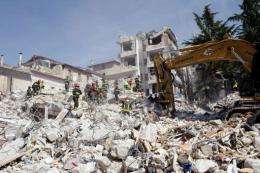Quake predictability still distant dream, say seismologists

Claims by an Italian technician to have foretold the devastating quake which struck central Italy prompted seismologists on Tuesday to shake their heads in sadness and skepticism.
No proven method exists, they said, for predicting earthquakes with any accuracy -- and the best way to save lives from Earth's wrath is to beef up construction standards and educate people about seismic risk.
"No scientist, as far as I am aware, anywhere around the world, has been able to predict an earthquake, in terms of saying exactly, when, where and how big it will be," Brian Baptie, a seismologist with British Geological Survey (BGS) in Edinburgh, told AFP.
"We know where earthquakes occur in certain parts of the world, we know for instance that earthquakes occur down the spine of Italy, in the San Andreas fault.
"But saying when and crucially how big they will be is beyond us at the moment. Prediction at the moment is just not possible."
Hours after the quake struck Italy's Abruzzo region on Monday, inflicting a death toll that on Tuesday rose beyond the 200 mark, Giampaolo Giuliani, a technician at the National Institute of Astrophysics, unleashed a storm.
He said he had predicted the event by detecting a surge in emissions of radon gas that leaked from stressed rocks, but his warning had been stifled by the authorities.
Remy Bossu, a researcher at the European-Mediterranean Seismological Centre (EMSC), said the idea of using radon, a radioactive gas naturally sequestered by certain rocks, as a telltale for impending quakes dated back to the 1970s.
"So far, nothing has been proven," he said.
"You have to know exactly what you are measuring," he said. "Radon emissions depend on many factors. For instance, if atmospheric pressure falls, it's easier for radon to escape from the earth's crust. It's very difficult to make a coherent comparison of emission levels."
"There are lots of people who are looking at radon levels in the world, and so far they have not been able to establish a correlation" with earthquake occurrence, said Yann Kinger of the Institute for the Physics of the Globe in Paris (IPGP).
In Monday's quake, "something must have happened in the Earth's crust for the radon concentrations to have changed," he said. "But was it pure coincidence that the earthquake happened just afterwards, or was there a connection?"
Other prediction methods that have been tried, tested and found flawed include using geo-electric sensors to measure large induced currents of electricity in rocks; monitoring flows of groundwater in seismic zones; and even using animals as zoological soothsayers.
Sometimes intriguing data emerge, but they have never developed into anything of use.
"To evacuate a civilian population, you have to know with high accuracy and reliability where the quake is going to occur, its magnitude and when it's going to happen," said Bossu.
"In addition, you have to be warned sufficiently early to get things organised. You don't evacuate a city in just 20 minutes."
At present, all seismologists can do is warn that a well-researched seismic zone is at risk of a bust at some point in coming years or decades.
Baptie said the picture was not entirely pessimistic.
More knowledge was accumulating as to how a major quake transmits energy to other parts of Earth's crust, building up pressure -- and thus the likelihood of a fault rupture -- elsewhere.
In long faults, this "domino" effect was demonstrated after the December 26, 2004 earthquake that unleashed the Indian Ocean tsunami.
Within months, it was followed, as predicted by Northern Ireland seismologist John McCloskey, by another massive temblor along the same fault west of Sumatra.
In the absence of a predictive tool, Baptie pleaded for strengthening and enforcing building standards and educating people in seismic zones about the danger.
"The type of places that are really at risk are these mega-cities in developing countries," he said. "They are at serious risk of a large earthquake that could cause a huge amount of damage."
(c) 2009 AFP














